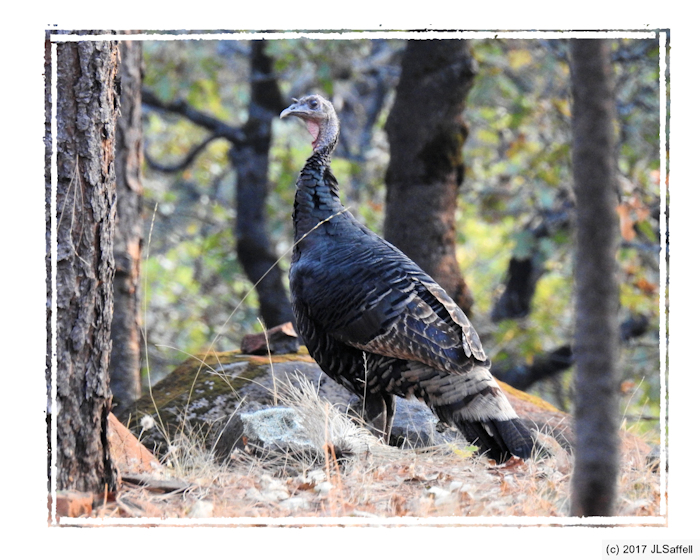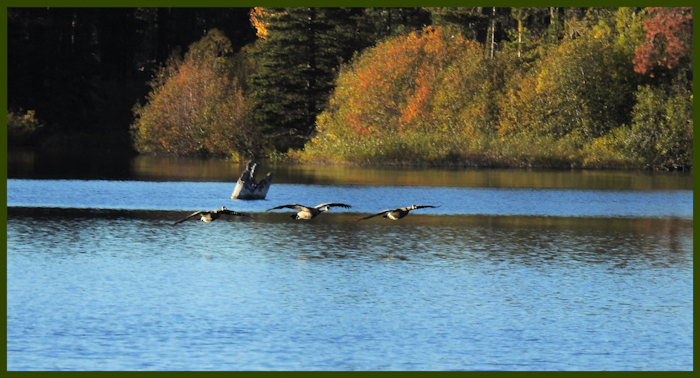WILDLIFE VIEWING AND PHOTOGRAPHY
Thought for today: Philippians 4:8 ..Whatever is true, whatever is noble, whatever is pure, whatever is lovely, whatever is admirable - if anything is excellent or praiseworthy, think about such things..
Disclaimer: There is no assurance that any resource or activity I've found or described will be as 'accessible' as you might need. Information or links may be out of date. Use the information at your own risk and be sure to check with your health care professional for exercise advice.
My best photos of deer and turkeys has been taken either from our front yard, out of our house window or from our vehicle while parked in our local forest. Mountain lions seem to use our driveway like a freeway, but in 18 plus years I've yet to see one beyond a disappearing tail, let alone capture it in a photo. I've seen one local bear running down the road, though several live on our property. I've seen some foxes, some bobcats, and other small predators, but wasn't fast enough to get a photo.

Photographing wildlife is not for the faint of heart. It takes patience, perseverance, happy timing and good locations. Fortunately, good locations for regularly spotting all sorts of wildlife are numerous in northern California.
Some inspiration for wildlife photography can be found at Lisa Langell's web site. Lisa also has a facebook group called 'Photography is a Journey', where you can find friends.
Your car/SUV is actually a really good choice as a portable photo blind and many pro's will tell you the same. Once you park, wild animals ignore it. Your car acts as a 'blind' and gives you a comfortable place to wait, too. If you park carefully, are mindful of your shooting angle and lighting, you can simply wait for the wildlife to walk into the shot. Simple, but complex all at the same time.
Take time to pick the background of your shot. Some natural landscapes are just more beautiful than others. If the weather is good, you can open up the windows on both sides of the car. With zoom, you might get a good shot out either window providing your partner isn't gawking out the same window when you want to snap the shutter.
Need more details about taking photos from your car? There's a good book on the topic: Photography From Your Car: Or Very Near by photographer J. Bruce.
The point is made that cars are perceived as non-threatening by wildlife. If you are inside the car you are part of the car. Once you exit the car everything changes. So, for photographing wildlife, your best bet may be to arrange your car to optimize your ability to get the perfect photo from inside the vehicle.
Personally, I think the best tip is to shut off the car engine to reduce camera shake and to have the window already down. A bean bag slung over the door frame is a pretty inexpensive camera support though I seem to have pretty good luck just bracing my elbows. It does take some practice to figure out how to get your shot without being a contortionist in your seat and how to keep the side mirror out of the frame - unless you want it in the frame which can provide some interesting views as well.
With a good zoom lens camera you can get closeups, action shots, and maybe, just maybe, something really special. That's one of the many reasons I love my Nikon p900 with its 83x zoom. It can really bring that distant animal into focus (no pun intended). I can FINALLY get some good wildlife photos when my timing is right without a lot of fumbling around. It makes photography fun!
For those more 'pro' than me, there 7 Tips on getting the photo from the car. Maybe you can get some great raptor pics.
The migratory bird flyways of Siskiyou and Modoc Counties host millions of birds in wetlands and waterways in spring and fall. It's always much easier to get pictures of birds in locations where they congregate in very large flocks.

The federal wildlife refuges, national parks and national forests all provide abundant opportunities for viewing larger game animals. Often the district offices will be able to provide some advice as to where certain kinds of animals are most often seen.
The Basin and Range Birding Trail includes 17 premiere birding sites.
Federal Wildlife Refuges in Northern California: https://www.fws.gov/refuges/refugeLocatorMaps/California.html Howard's Gulch Campground near Canby, mentioned in the article above is described as wheelchair accessible with some assistance. Picnic at the Day Use areas and walk the trail which often has woodpeckers in sight.
Legal Wildlife Photography in the USA
Lastly, (and I hate having to bring this up) there can be legal ramification to wildlife photography. If you are a professional photographer earning any money selling photographs or digital images, photographing others for pay, or your photo activities fall into the 'commercial' category, then you may need to read up on the photography rules for federal lands, and separately read up on the rules for state lands.
In general, still photography without props or models even for professionals does not trigger a need for a permit. But, interpretation among federal and state agencies can differ, so be aware of the possibility. Amateur photographers who are doing 'still' photography without models or props should be fine. Same goes for cell phone cameras. Shooting hand-held is seldom questioned. Shooting with a tripod is generally fine on federal lands. Shooting with a whole group of people (like with a camera club) could be problematic unless it is a pre-planned event.
Photographing wildlife on federal public lands
The Federal Wildlife Refuges encourages photography.
US Forest Service has some guidelines on wildlife photography.
Photographing on California State Lands
Where you can run into photographic legal problems is on state lands in California. There is a large interpretation of what constitutes commercial use of photography. In general, it seems terribly subjective - if you are on public lands by yourself with a handheld camera you may be ok. Add a tripod, and you may or may not be considered as 'amateur' by local officials.
Of course, many cell phones take really good photos. That can always be an option for an Amateur Photographer. If I ever get a fancy smart phone, it will have to have a good camera. But I'm old fashioned - I use a real camera.
California Parks have posted Film Policies. General California State film policies are posted, too.
'Who needs a permit? Anyone engaged in commercial (profit and sale) photography on state property - whether still, motion picture, or digital, for print, TV, theatres, or the Internet - is required to obtain a film permit from the CFC. Student filmmakers are also required to get a permit. If you are taking stills or filming for personal use without 'commercial' equipment at a state park or beach, you don't need a permit.'
If someone 'official' objects to your taking photos, just smile, be polite and leave the area. Then write letters!